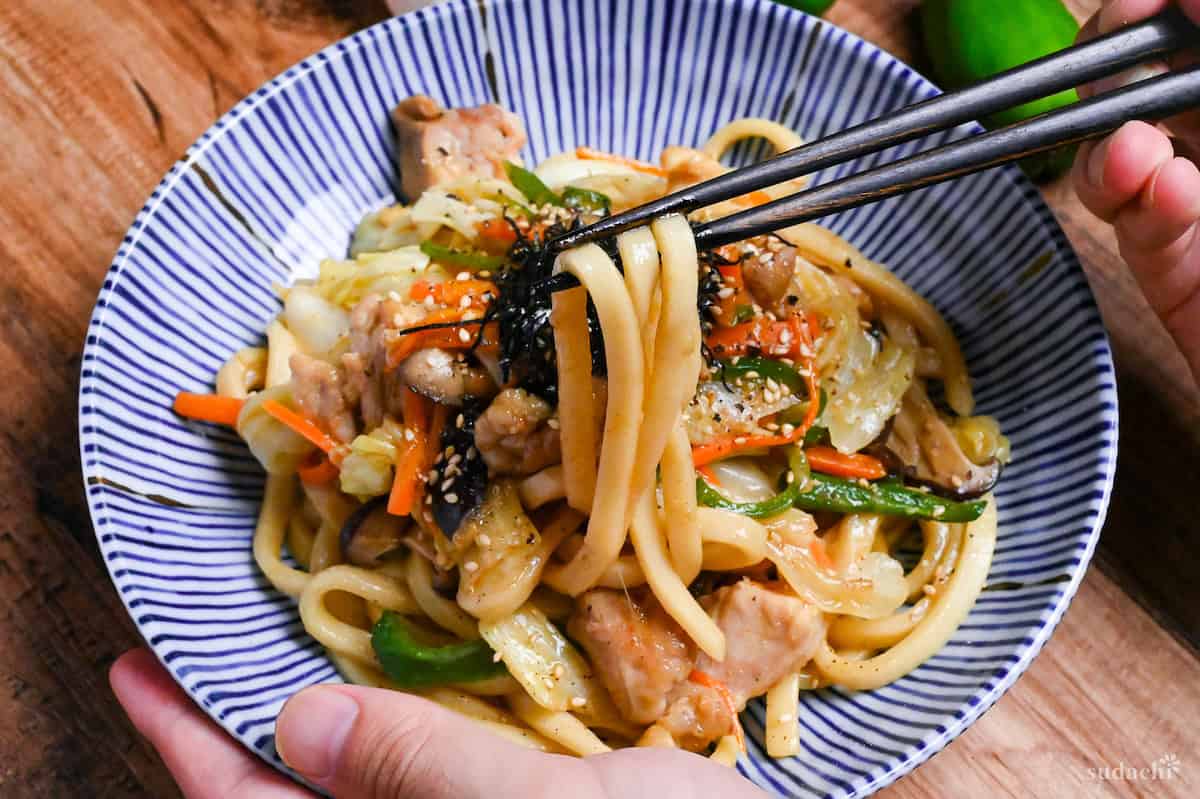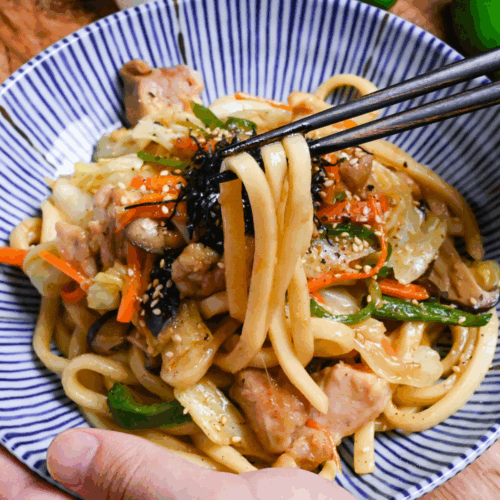How I Developed This Recipe
Can you really make tasty yaki udon faster than you can scroll through the menu on your delivery app? As someone who grew up making this Japanese stir-fried noodle dish, I promise you can have steaming, savory udon twirling around your chopsticks in under 20 minutes without waiting, with no delivery fees.
Designed for busy schedules and novice Asian-pantry explorers alike, this recipe includes clear instructions and easy substitutions.

My recipe is different not only because of its speed, but also because of its unique ingredients and techniques. It’s about how I layer the flavors and when I add each ingredient. Let me show you exactly how it works.
Key Ingredients & Substitution Ideas

- Udon noodles: Fresh, dried, refrigerated, or frozen varieties all work for this dish.I recommend slightly undercooking them compared to the package directions, since they’ll finish cooking in the pan. For convenience on busy weeknights, I personally prefer refrigerated or frozen udon. They’re readily available at most Asian grocery stores.
- Balsamic vinegar: Although it’s an unconventional ingredient for yaki udon, balsamic vinegar was found to be the best option after testing various alternatives. It provides the perfect acidic balance that ties all the flavors together without overpowering the dish. No balsamic? Chinese black vinegar or a squeeze of lemon plus a pinch of brown sugar gives a similar balance.
- Oyster sauce: I rely on a good-quality bottle to add depth that soy alone can’t match. For vegetarian versions, look for mushroom-based oyster sauce alternatives with similar umami intensity. If you have an allergy to those ingredients you can mix equal parts hoisin and soy as a last-resort stand-in.

- Chicken thighs: Feel free to customize this protein based on your preferences. Thinly sliced pork, chicken breast, or even meaty mushrooms like king oyster are great. My personal favorites are chicken thighs for their juicy flavor or thinly sliced pork belly for that authentic Japanese touch.
- Vegetables: This is where yaki udon truly shines. You can incorporate virtually any vegetables you have on hand or whatever’s seasonal in your area. I love using bell peppers, cabbage, carrots, or onion for color and crunch. Just be mindful of water content! Vegetables like zucchini or bean sprouts can release excess moisture and make your entire dish too soggy.
Visual Walkthrough & Tips
Here are my step-by-step instructions for how to make Chicken Yaki Udon at home. For ingredient quantities and simplified instructions, scroll down for the Printable Recipe Card below.
This section aims to provide a comprehensive overview of the cooking steps and techniques with visuals. It also includes more in-depth tips and tricks and explains why I do what I do.
Toss the chicken thighs in salt and all-purpose flour until each piece is lightly coated.

We’ll then cover it and put it in the fridge while we prepare the vegetables.

For the vegetables, thinly slice the onion and shiitake mushrooms, julienne the bell peppers and carrots, and chop the cabbage into rough pieces.

Heat your wok or large frying pan over low heat, then add butter and lard, along with a minced garlic clove, grated ginger, and sliced onion. Cook these slowly for 3 minutes, stirring gently.

Low-temperature cooking allows the onions to release their natural sweetness through enzymatic breakdown. The garlic and ginger also release their volatile compounds more gradually, preventing them from burning and producing bitter notes.
Using both butter and lard can also create a complex flavor profile. Butter contributes nutty, dairy notes while lard provides clean richness and a higher smoke point.

Crank the heat to medium, add the chicken pieces skin-side down if you have skin, and let them sit undisturbed until each side shows a golden crust.

Flipping too soon or stirring constantly will tear that crisp coating right off! Patience here pays off in texture and taste.

Turn the heat to medium-high and add cabbage, bell peppers, shiitake mushrooms, and carrot. Immediately season with oyster sauce, mirin, sugar, and dashi granules.

Stir-fry until the vegetables are just tender but still have some bite.
Slide the pre-cooked udon noodles into the pan, then blast with high heat for about a minute, tossing so each strand glistens with sauce.

Tilt the pan slightly and pour soy sauce around the edge so it sizzles on the hot metal. Adding soy sauce to the hot pan edges triggers the Maillard reaction, creating aromatic compounds like HEMF that give that distinctive “wok-fried” aroma.

Turn off the heat, then swirl in cold butter and a splash of balsamic vinegar.
Although it’s not a common ingredient for this dish, I find the acetic acid in balsamic vinegar brightens the entire dish by balancing the rich, fatty components. Its natural sweetness complements the umami elements without overpowering them. Black vinegar or a squeeze of lemon juice work as excellent substitutes.

Finishing with cold butter to create a glossy, rich sauce. Adding it off the heat preserves the butter’s delicate flavor compounds that would be destroyed by direct high heat.
Transfer to serving plates and finish with freshly cracked black pepper, a drizzle of chili oil, toasted white sesame seeds, and shredded nori seaweed.


Essential Tips & Tricks
- Start with low heat for aromatics – Cook garlic, ginger, and onions slowly to build sweet, mellow flavors.
- Don’t skip the flour coating – This creates a protective barrier that keeps chicken juicy and adds the perfect crispy texture without heaviness.
- Use the pan edge for soy sauce – Pour soy sauce around the hot pan edges, not directly on food, to create that signature “wok-fried” aroma.
- Add final butter off the heat – This preserves the butter’s delicate flavor and creates a glossy finish.
- Use a large pan or wok – Overcrowding leads to steaming instead of proper stir-frying, resulting in soggy vegetables and pale chicken. A large wok will prevent this.
With these simple tips in mind, you’re set for success every time you make this Yaki Udon.
Meal Prep & Storage
This butter-soy chicken udon isn’t ideal for full-dish make-ahead because once sauced and stirred, the udon strands will soften and lose their signature chew.
For meal prep, cut the vegetables and store them in an airtight container in the fridge up to 2-3 days in advance for streamlined cooking on weekdays.
To store leftovers, allow to cool at room temperature for no more than 90 minutes, then transfer into an airtight container, and refrigerate promptly. Consume within 48 hours but expect some texture deterioration over time.
Serving Suggestions

FAQ
Here are answers to frequently asked questions I have received across all platforms, including here, YouTube, Instagram, and Pinterest. If you have any questions, feel free to send them to me anytime! It will be a big help for everyone in this community!
It happens when there’s free starch on the noodle surface that gelatinizes, and the noodles stick without enough oil or agitation. Rinse your pre-cooked udon under cold water first to wash off any loose starch. Use enough oil to coat every strand, and gently flip instead of vigorous stirring. High heat and short tosses, rather than long, slow cooking, will keep each noodle separate.
Vegetables like cabbage and bean sprouts release a lot of water when they cook, which can dilute your sauce. If you want to use large amount of vegetables, first stir-fry them over high heat, then remove the vegetables while you cook the chicken and noodles. Add them back right before you pour the sauce on so they stay crisp and don’t make the pan soggy.
Don’t overcrowd your pan. Use a 26cm+ pan for 2 servings max. Cooking too much at once lowers the temperature and leads to steaming instead of proper stir-frying, resulting in soggy vegetables and gummy noodles. If you’re working with a lot of stuff, make sure to cook in batches.
Recipe Update: June 2025
I updated this chicken yaki udon recipe significantly in June 2025 with better techniques and flavors! If you’d like to try my original version, you can still find it on my YouTube channel.
I hope you enjoy this Chicken Yaki Udon recipe! If you try it out, I’d really appreciate it if you could spare a moment to let me know what you thought by giving a review and star rating in the comments below. It’s also helpful to share any adjustments you made to the recipe with our other readers. Thank you!
More Stir-fry Recipes

20-Min Japanese Chicken Yaki Udon Noodles
Ingredients
- 250 g boneless chicken thigh bitesize pieces
- ⅛ tsp salt
- ½ tbsp all-purpose flour
- 50 g onion
- 2 fresh shiitake mushrooms
- ½ bell pepper seeds and pith removed
- ½ carrot
- 150 g green cabbage
- 1 tsp butter
- 1 tsp lard
- 1 clove garlic
- 1 tsp ginger root
- 1 tsp dashi granules
- 1 tsp mirin
- ½ tsp oyster sauce
- ¼ tsp sugar
- 2 portions udon noodles pre-cooked, ready to use type
Finishing
- ½ tbsp Japanese soy sauce (koikuchi shoyu)
- ½ tbsp butter
- ¼ tsp balsamic vinegar
- ground black pepper to taste
- toasted white sesame seeds to taste
- kizami nori (shredded nori) to taste
- chili oil (rayu) to taste
My recommended brands of ingredients and seasonings can be found in my Japanese pantry guide.
Can’t find certain Japanese ingredients? See my substitution guide here.
Instructions
- Cut 250 g boneless chicken thigh into bitesize pieces, then sprinkle with ⅛ tsp salt and ½ tbsp all-purpose flour. Toss until evenly covered, then cover and refrigerate while you prepare the other ingredients.

- Thinly slice 50 g onion and 2 fresh shiitake mushrooms, and julienne ½ carrot and ½ bell pepper. Chop 150 g green cabbage into rough bitesize pieces and set by the stove.

- Heat a wok on medium low and melt 1 tsp butter and 1 tsp lard. Grate 1 clove garlic and 1 tsp ginger root straight into the wok, add the onion and fry for 3 minutes or until fragrant and the onion is slightly softened.

- Increase the heat to medium and push the onions and aromatics to one side. Place the chicken pieces in the wok with the skin side facing down and fry undisturbed. Once golden and slightly crispy, flip and sear on the other side.

- Once the chicken is seared all over, add the cabbage, carrot, bell pepper and mushrooms. Flavor with 1 tsp dashi granules, 1 tsp mirin, ½ tsp oyster sauce and ¼ tsp sugar. Stir fry everything together until the condiments are evenly distributed and the vegetables are tender-crisp.

- Increase the heat to high and add 2 portions udon noodles. Mix and toss until the ingredients are evenly distributed, then pour ½ tbsp Japanese soy sauce (koikuchi shoyu) around the edge of the pan.

- Turn off the heat and add ½ tbsp butter and ¼ tsp balsamic vinegar. Toss a few times then transfer to serving plates.

- Garnish with ground black pepper, toasted white sesame seeds, kizami nori (shredded nori) and optionally, a drizzle of chili oil (rayu). Enjoy!

Notes
- Cut all vegetables to similar size and thickness for quick, even cooking.
- For fresh or dried noodles (not “ready to use” type), cook slightly less than package instructions, then rinse with water to remove excess starch.
- Add a small amount of lemon juice or vinegar if you prefer a tangier flavor.
- Substitute with any other stir-fry vegetables as desired.
- For leftovers, cool to room temperature within 90 minutes, store in airtight containers in the fridge for up to 2-3 days, and reheat over medium heat with a splash of water to revive texture.






Leave a rating and a comment